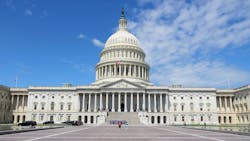The U.S. House Appropriations Committee is weighing in on major regulatory issues in trucking, including hair testing, speed limiters, congestion pricing, and more.
The committee on July 10 passed two major fiscal year 2025 appropriations bills that would fund the Department of Transportation and Department of Health and Human Services.
The funding bill for HHS further pressures the department to develop hair testing guidance for DOT. The funding bill for DOT, first released in late June, includes a wide swath of significant policy directives concerning trucking. However, both bills still face a long and volatile legislative process.
Pressure on HHS for hair testing guidance
The House Appropriations Committee is pressuring the Department of Health and Human Services to establish appropriate hair testing guidance for truck drivers.
The committee passed its fiscal year 2025 appropriations bill for the Departments of Labor, Health and Human Services, Education, and related agencies on July 10. In its report on the appropriations bill, the Appropriation Committee explicitly directs HHS to produce guidance for the use of hair testing as an alternative drug testing method for commercial vehicle drivers.
“The Committee also recognizes that since the FAST Act was signed into law, our nation has experienced a crippling substance use epidemic—particularly from opioids and synthetic opioids—and Federal inaction to recognize hair testing as a viable alternative to urinalysis has denied Americans a legitimate tool to stem the crisis,” the report states. “This is a glaring reminder that drug-impaired driving remains a serious issue and poses a tremendous risk to the safety of the motoring public.”
Furthermore, the committee requests that HHS provide an update on its hair testing method efforts after one year.
This push for hair testing is more of a suggestion than a requirement: It exists in the committee’s report on its appropriations bill but not in the language of the bill itself. The report accompanies the bill, providing detailed information about legislators’ intent. However, agencies still tend to follow the report’s suggestions.
The American Trucking Associations commended the committee’s push for HHS hair testing guidance.
“For far too long and across multiple administrations, HHS has ignored a congressional directive and dragged its feet on creating an option for motor carriers to use hair testing to deter and detect drug use. This interminable delay is unacceptable and inexcusable, and it puts highway safety at risk,” said Chris Spear, ATA president and CEO. “We appreciate the House Appropriations Committee exerting pressure on HHS to finalize its long-overdue guidance and implement this proven method for drug testing.”
The federal government directed HHS to develop hair testing guidelines for DOT drug testing in late 2015. HHS finally published guidelines in 2020, but with the stipulation that positive hair tests must be confirmed by a follow-up urinalysis test.
See also: Trucking’s hair testing wait rolls on
DOT’s funding bill passes appropriations
The House Appropriations Committee also passed its funding bill for the Departments of Transportation, Housing, Urban Development, and related agencies. The bill, which allocates $90.4 billion for all relevant agencies, has several noteworthy sections for the trucking industry.
Among many other things, the bill:
- Dedicates $200 million to support truck parking availability
- Bars electronic logging device mandates for livestock carriers
- Prohibits speed limiter requirements for heavy commercial vehicles
- Blocks congestion toll programs
- Limits support for California and Washington meal and rest break rules
- Combats the transportation greenhouse gas emissions performance measure rule
- Reduces funding for DOT grant programs overall
The bill’s report also asks that FMCSA work with stakeholders to develop guidelines combating predatory towing. This language, however, is not in the bill proper.
“The Committee recognizes that unethical practices in nonconsensual towing and recovery are creating challenges for interstate motor carriers whose equipment, safety, and maintenance practices are regulated at the Federal level,” the report stated. “The Committee urges FMCSA to facilitate discussions with local, state, and private sector stakeholders to develop guidelines for towing and recovery regulation at all levels of government.”
ATA’s president and CEO applauded the report’s suggestion for FMCSA.
“Charging truck owners thousands of dollars for each unwanted tow and holding cargo hostage with excessive invoices are egregious practices that disrupt our supply chain,” Spear said. “We welcome this important step forward to develop commonsense reforms that will inject more transparency and fairness into the system and hold unscrupulous companies accountable.”
What happens next
The two appropriations bills still face a lengthy and volatile legislative process. They will now go through the House and Senate proper.
The bills will likely undergo significant revisions: They must be reconciled with the Senate’s own appropriation bills, align with a majority of senators’ and representatives’ political goals, and receive the president’s approval before enactment.
The funding bill for transportation, particularly, includes major directives on partisan issues. Major revisions are still likely. This is the same legislative process that frequently threatens a government shutdown over legislators’ policy conflicts.
About the Author
Jeremy Wolfe
Editor
Editor Jeremy Wolfe joined the FleetOwner team in February 2024. He graduated from the University of Wisconsin-Stevens Point with majors in English and Philosophy. He previously served as Editor for Endeavor Business Media's Water Group publications.

